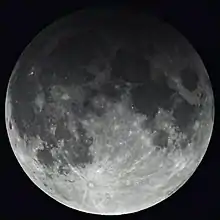January 2048 lunar eclipse
A total lunar eclipse will take place on January 1, 2048. It will be the first recorded lunar eclipse to be visible on New Year's Day for nearly all of Earth's timezones. The next such eclipse will occur in 2094.
| Total eclipse | |||||||||||||||||
 | |||||||||||||||||
| Date | 1 January 2048 | ||||||||||||||||
|---|---|---|---|---|---|---|---|---|---|---|---|---|---|---|---|---|---|
| Gamma | −0.3745 | ||||||||||||||||
| Magnitude | 1.1280[1] | ||||||||||||||||
| Saros cycle | 135 (25 of 71[2]) | ||||||||||||||||
| Totality | 55 minutes 56 seconds | ||||||||||||||||
| Partiality | 214 minutes 16 seconds | ||||||||||||||||
| Penumbral | 359 minutes 26 seconds | ||||||||||||||||
| |||||||||||||||||
Visibility

Related lunar eclipses
Lunar year series
| Descending node | Ascending node | |||||
|---|---|---|---|---|---|---|
| Saros | Date Viewing |
Type Chart |
Saros | Date Viewing |
Type Chart | |
| 115 | 2046 Jan 22 |
Partial |
120 | 2046 Jul 18 |
Partial | |
| 125 | 2047 Jan 12 |
Total |
130 | 2047 Jul 07 |
Total | |
| 135 | 2048 Jan 01 |
Total |
140 | 2048 Jun 26 |
Partial | |
| 145 | 2048 Dec 20 |
Penumbral |
150 | 2049 Jun 15 |
Penumbral | |
| Last set | 2045 Aug 27 | Last set | 2045 Mar 03 | |||
| Next set | 2049 Nov 09 | Next set | 2049 May 17 | |||
Half-Saros cycle
A lunar eclipse will be preceded and followed by solar eclipses by 9 years and 5.5 days (a half saros).[3] This lunar eclipse is related to two total solar eclipses of Solar Saros 142.
| December 26, 2038 | January 5, 2057 |
|---|---|
 |
 |
References
- For a partial or total lunar eclipse, this value denotes the umbral magnitude. For a penumbral lunar eclipse, this denotes the penumbral magnitude.
- Lunar Saros 135 - Fred Espenak's GSFC Eclipse Canon
- Mathematical Astronomy Morsels, Jean Meeus, p.110, Chapter 18, The half-saros
This article is issued from Wikipedia. The text is licensed under Creative Commons - Attribution - Sharealike. Additional terms may apply for the media files.

_(cropped).jpg.webp)
